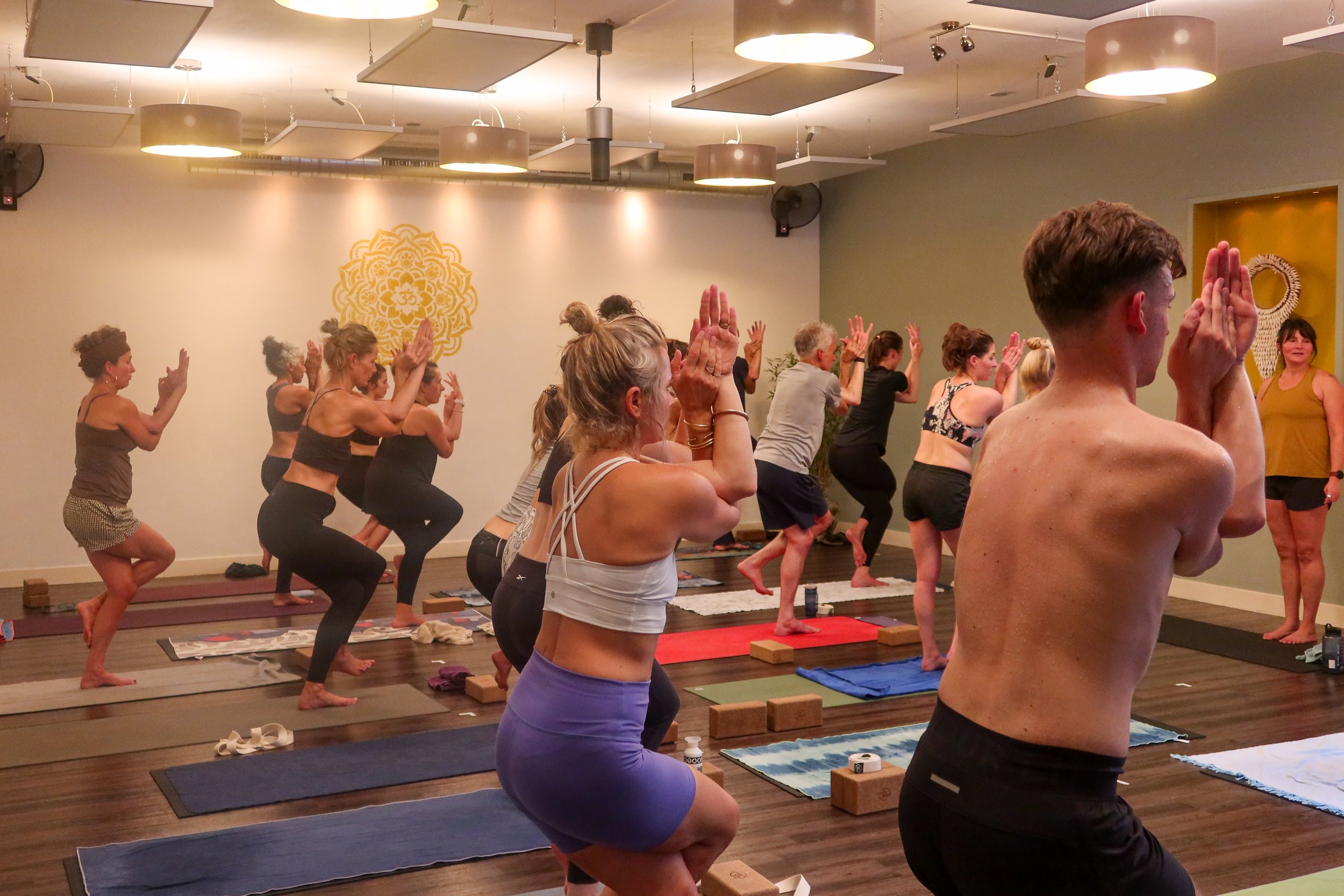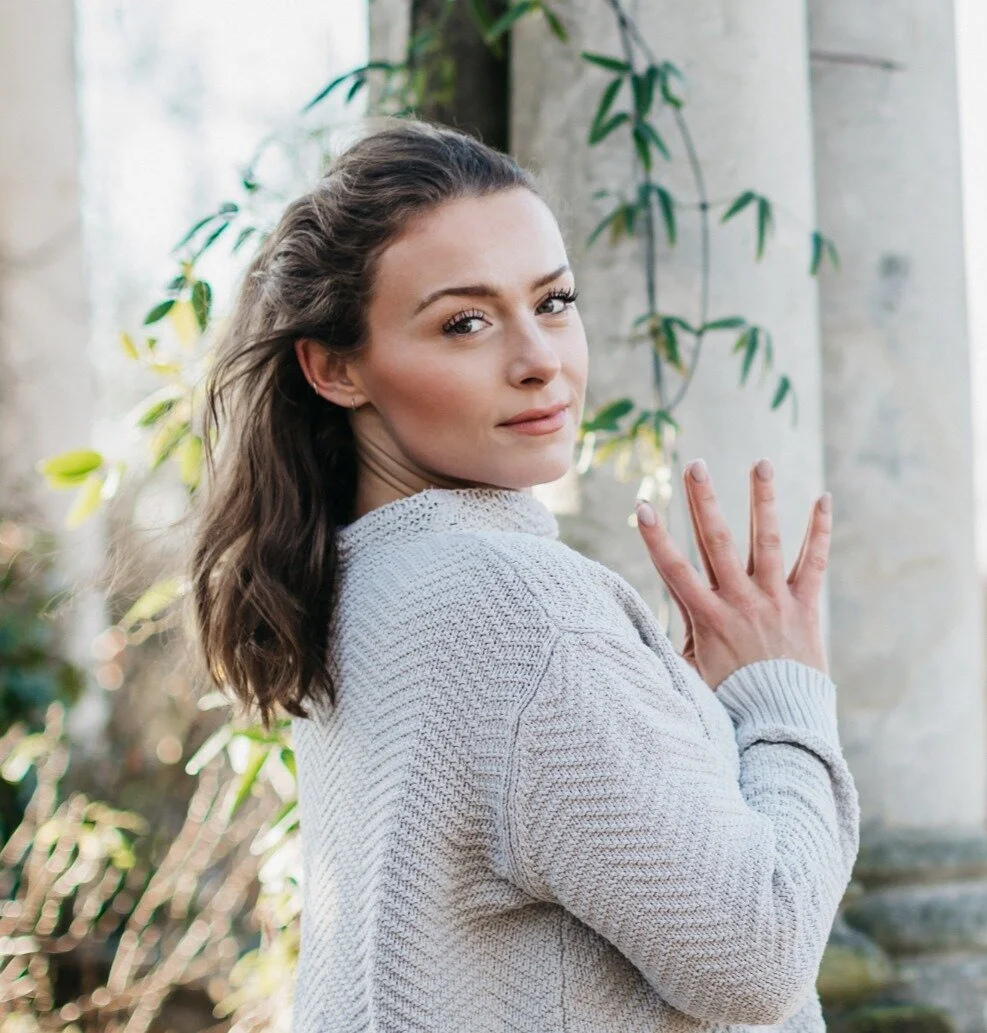
Tapasya Hot Yoga
Be with intensity for the sake of transformation.
Transformation through tapas
Tapasya Hot Yoga (pronounced tah-pah-syah), is a transformative and empowering, alignment-based method of Hot-Hatha and Hot-Hatha-Vinyasa yoga created by Kristin Campbell in 2012. Tapasya was thoughtfully designed to be safe, empowering, and deeply introspective, meeting students exactly where they are. The methodology is supported by a clear philosophical framework, with specific alignment, sequencing, cueing, and timing principles.
Tapasya Hot-Hatha + Hatha-Vinyasa inspired classes and teacher trainings are being offered in the UK, Europe, and Canada.
Why hot?
The temperature is an integral part of the method, supporting:
Muscle elasticity and range of motion. Warm muscles produce a more effective stretch, allowing for a greater range of motion. Cold muscles don’t absorb shock and impact as well and do not stretch as easily and can be more susceptible to injury.
Stress-relief and nervous system regulation. The heat and intensity of the practice elevate heart rate and promote sweating, which can feel cleansing and cathartic. While the liver and kidneys are the body’s primary detoxification organs, sweating supports temperature regulation and nervous system release. Combined with focused attention and breath, this helps reduce stress, discharge tension, and leave practitioners feeling calmer and mentally refreshed.
Increased circulation. Heat enhances blood flow, supporting more efficient delivery of oxygen and nutrients throughout the body.

Why hot Yoga?
KEY CHARACTERISTICS OF A TAPASYA INSPIRED CLASS
Opening and closing breath practices to settle, integrate and cool down.
Wrist-light, with mostly standing postures and limited arm balances.
Set sequence that is logical, progressive, accessible and offers measurable results.
Standing one-legged balancing poses increase focus, balance, proprioception, coordination, and stamina.
Whole-body focused, moving the spine through all three planes: flexion, extension, and rotation.
Specific pose timings, in a world with so much uncertainty, this is a well-rounded practice with specific timings to create a consistent structure that you can count on.
Joint therapy, through compression-and-release effects in some postures to stimulate blood flow, clear stagnation, break down scar tissue and flush joints with lubricating synovial fluid.
Organ massage and lymphatic drainage. Many of the postures massage the organs and lymphatic system to activate the body’s innate cleansing processes.
Mental and physical endurance, the practice is much like interval training with little peaks and valleys throughout. It teaches you ‘right use of energy’. You become very efficient with how you use your energy, knowing when to perform and when to rest.
Empowering. The practice gently confronts personal boundaries and limitations, building your capacity to meet challenges head-on.
Meditative. The stillness, heat, and structure naturally cultivate dharana (concentration) and dhyana (meditation). Practitioners are invited into self-study—observing physical sensation, breath, and mental patterns without judgment.
“A physical system that has not been subjected to the purifying fire of an arduous tapasya is like a raw earthen vessel, insufficiently baked, which splits and spills when poured into it.”
~ Sanskrit Dictionary

What to expect :
The room is heated to approximately 40°C with approximately 40% humidity.
There is an emphasis on alignment, breath awareness, flexibility, strength, and self-regulation, leaving practitioners with a grounded calm and a radiant, sweaty glow. The practice is active and dynamic, yet intentionally non-flowing—there are no Sun Salutations and few linking poses. Instead, postures are held statically for specific, timed durations, rather than being breath-led.
This structure takes the risk out of transitions and allows students to fully embody each shape. Static poses cultivate strength, patience, and clarity, inviting a dynamic inner experience through stillness. Each standing posture is followed by a moment of rest in Tadasana pose, creating natural peaks and valleys throughout the class. Over time, this builds stamina, endurance, and the capacity to find calm within intensity.
“In this space, my mind quiets. Thoughts move into the background, while my breath and connection to my body come into the foreground of the experience. Pre-existing agitations and stresses are burned away in the fire of this transformative practice. I leave feeling both well-tested and well-rested—completely wrung out, reset, and grounded.
Tapasya isn’t just about hot yoga; it’s about leaning into those uncomfortable edges, where the ego sits. It’s about transforming the ego or “inner critic” and getting to the root of who you truly are at your core. The intensity of the environment brings me into my body. When intensity is met with intensity, burnout follows. This practice teaches the right use of energy—self-regulation, discernment, and restraint.
The heat and focus required call me into presence. From that presence, the practice becomes meditation in motion. It wasn’t always this way for me. In the beginning, I was distracted, fidgety, and reactive to the experience. Over time, I came to see that those reactions were simply expending energy—energy that could instead be directed into the practice itself.”
My hot yoga teaching journey.
I have been teaching Hot Yoga since 2000 and I am passionate about the transformative potential of the practice.
I got hooked on Bikram yoga back in the late 90s. My approach to hot yoga at that time was fierce, as the setting in a Bikram class can often promote. This resulted in me having some repetitive stress injuries. I came to realize that it wasn’t the yoga causing my injuries, it was my approach. Yoga should not hurt!
Around that time, I was introduced to the Anusara Yoga and the Universal Principles of Alignment™. I started incorporating these principles to my practice and the pain and instability I was experiencing in my lower back, psoas and SI joint miraculously disappeared. It wasn’t only the application of these alignment principles that transformed my practice, it was my approach. Through the Tantric teachings offered in an Anusara class, I discovered that “alignment” is not limited to the physical body, how you align yourself spiritually is equally, if not more important. The attitude or intention that you come to your mat with informs how and where you place yourself. If how you show up and approach your practice doesn’t match your intention for being there, you are out of alignment. Through this awakening, I became much happier and softer.
From 2002-2010, I owned a studio called NeoAlpine Yoga in the ski resort town of Whistler BC. I taught Bikram Yoga for eight years, along with Power Vinyasa and Yin. Just as my approach to the practice was shifting, so was the way I was teaching Bikram yoga, and there was incredible receptivity from my students.
I saw a need for a mindful, alignment-based style of hot yoga so I created one.
In 2008, I took Bikram Yoga off the schedule and started teaching what I called Hot Fusion until I partnered with YYoga shortly thereafter. Hot Fusion morphed into YHot, and in 2012 I launched Tapasya Hot Yoga which is based on a set series that is a creative synthesis of over 22+ years of yogic study in several established Hot and Hatha yoga styles; Bikram, Baptiste Power Vinyasa, and Anusara (which has its roots in Iyengar and Tantric philosophy).
WHO IS HOT YOGA FOR?
The practice is an intelligently sequenced, foundation-based practice with traditional asanas. It is accessible to beginners and engaging for advanced practitioners alike, offering a well-rounded experience that continually brings students back to the basics.
The method is non-dogmatic—the practice speaks for itself. Teachers hold space with care and precision, and students consistently leave feeling supported, uplifted, and better about themselves than when they arrived.
FAQs
-
Arrive well hydrated and avoid eating a heavy meal 1.5 - 2hrs before a class to optimize your experience.
Humans are adaptable; it can take 3–5 classes to acclimate to the heat and learn how to use your energy sustainably throughout the class.
Breath regulation is key. Practicing with your mouth closed helps keep the nervous system calm and regulated, and your breath becomes a reliable barometer for effort. If your breathing becomes erratic, you feel the urge to open your mouth, or you notice breath-holding, it’s a sign to ease back—reduce effort by about 10% or take a pause. You are always welcome to lie down in savasana, remaining in the room until your breath returns to a steady, calm rhythm before rejoining the practice.
Maintain a balance of effort and ease. The asanas are designed to free the body and mind from tension and stress and should be practiced with alertness, steadiness, and ease.
-
Some people think you aren't supposed to practice yoga in the heat, people think it's dangerous, and that people might over-stretch. To me, this says more about how one might approach their practice, over the temperature of the room.
Some people believe that the repetitiveness of a set sequence gets boring or limiting in some way. Yoga is not meant to be entertainment for the mind. In fact, the practice of yoga is meant to cease the fluctuations of the mind. Sure, repetitive movement can be a cause for checking out and for going on auto-pilot, or, through repetition, the mind calms and one may experience meditation. Similar to doing japa meditation with a mala (prayer beads), each little mini sequence within the whole set sequence are little malas. Many students appreciate that they don't have to think. They have busy lives where they have to make decisions all day or have high-stress in their lives. There is already so much uncertainty in the world. Here the mind can rest, knowing what comes next offers the practitioner a sense of peace. All you have to do is show up and follow the teacher’s prompts.
-
Come as you are, this is yoga for every-body and flexibility will come, physically and mentally.
Testimonials





